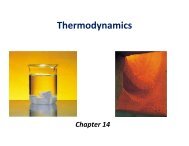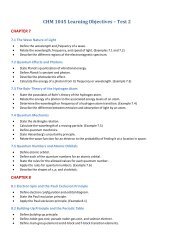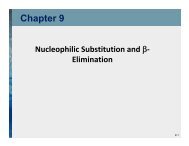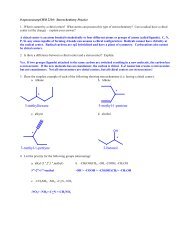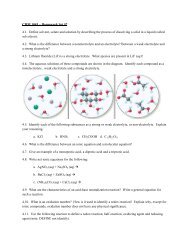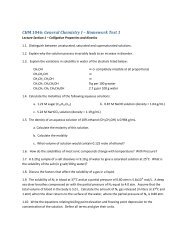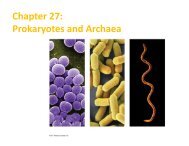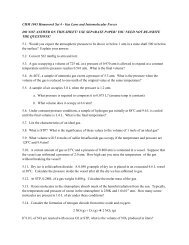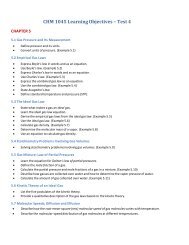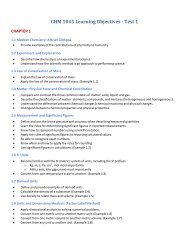CHM 1046 Lecture 3 homework
CHM 1046 Lecture 3 homework
CHM 1046 Lecture 3 homework
You also want an ePaper? Increase the reach of your titles
YUMPU automatically turns print PDFs into web optimized ePapers that Google loves.
<strong>CHM</strong> <strong>1046</strong> <strong>Lecture</strong> #3 –Batteries<strong>Lecture</strong> 7 – Electrochemistry7.1. Balance the following redox reactions:a. H 2 O 2 + Fe 2+ Fe 3+ + H 2 O (Acidic)b. Cu (s) + HNO 3 Cu 2+ + NO (g) + H 2 O (Acidic)c. CN ‐ + MnO ‐ 4 CNO ‐ + MnO 2 (Basic)d. Br 2 BrO ‐ 3 + Br ‐ (Basic)e. S 2 O 2‐ 3 + I 2 I ‐ + S 4 O 2‐ 6 (acidic)7.2. Balance the following redox reactions:a. Mn 2+ + H 2 O 2 MnO 2 + H 2 O (Basic)b. Bi(OH) 3 + SnO 2‐ 2 SnO 2‐ 3 + Bi (Basic)c. Cr 2 O 2‐ 7 + C 2 O 2‐ 4 Cr 3+ + CO 2 (Acidic)d. ClO ‐ 3 + Cl ‐ Cl 2 + ClO 2 (Acidic)7.3. What is the function of a salt bridge? What kind of electrolyte should be used in a salt bridge?7.4. What is the equilibrium constant for the following reaction at 25 o C?Mg (s) + Zn 2+ Mg 2+ + Zn (s)7.5. Calculate ΔG o and K c for the following at 25 o C:a. Mg (s) + Pb 2+ (aq) Mg 2+ + Pb (s)b. Br 2 (l) + 2I ‐ 2 Br ‐ (aq) + I 2 (s)c. O 2 (g) + 4H + + 4Fe 2+ 2H 2 O (l) + 4Fe 3+d. 2Al (s) + 3I 2 (s) 2Al 3+ + 6I ‐ (aq)
7.6. Write the Nernst equation and define all terms.7.7. What is the potential of cell made up of Zn/Zn 2+ and Cu/Cu 2+ half‐cells at 25 o C if [Zn 2+ ] = 0.25 M and[Cu 2+ ] = 0.15M?7.8. Calculate Eo, E and DG for the following cells:a. Mg (s) + Sn 2+ Mg 2+ + Sn (s), [Mg 2+ ] = 0.045 M, [Sn 2+ ] = 0.035 Mb. 3Zn (s) + 2Cr 3+ 3Zn 2+ + 2Cr (s), [Zn 2+ ] = 0.0085 M, [Cr 3+ ] = 0.010 M7.9. What is the difference between a galvanic cell and an electrolytic cell?7.10. Calculate emf for : Mg(s)|Mg 2+ (0.024M)||Mg 2+ (0.053M)|Mg (s)7.11. The passage of current of 0.750 A for 25.0 min deposited 0.369 g of Copper from a CuSO 4 solution.Calculate the molar mass of copper from JUST this information.7.12. The SO 2 percent in air is mainly responsible for the phenomenon of acid rain. The concentrationof SO2 can be determined if by titrating against a standard permanganate solution as follows:5SO 2 + 2MnO 4 ‐ + 2 H 2 O 5SO 4 2‐ + 2Mn 2+ + 4H +Calculate the number of grams of sulfur dioxide in a sample of air if 7.37 mL of 0.00800 M KMnO 4 arerequired for the titration.7.13. Oxalic acid (HC 2 O 4 ) is present in many plants and vegetables. A) balance the following equation inacid solution,MnO 4 ‐ + C 2 O 4 2‐ Mn 2+ + CO 2b) if a 1.00 g sample of oxalic acid requires 24.0 mL of 0.0010M KMnO 4 to reach the equivalence pointwhat is the percent by mass of oxalic acid in the sample?7.14. Calcium oxalate (CaC 2 O 4 ) is insoluble in water. This property has been used to determine theamount of ionic calcium in blood. Tha calcium oxalate is dissolved in acid and titrated against standardKMnO 4 as in problem 7.13. In one test, the amount of calcium from 10.0 mL of blood required 24.2 mLof 9.56x10‐4 M KMnO 4 . Calculate the number of milligrams of calcium per milliliter of blood.7.15. A spoon was silver plated electrolytically in AgNO 3 solution. A) Sketch a diagram of this occurring.B) If 0.884 g of silver was deposited on the spoon at a constant current of 18.5 mA, how long did theelectrolysis take?
Complex Coordinate Compounds8.1 Explain why atomic radii decreases gradually from scandium to copper.8.2 Why do transition metals have more oxidation states than other elements?8.3 Define the following terms: coordination compound, ligand, donor atom, coordination number andchelating agent8.4 In the complex [Cr(C2O4)2(H2O)2]‐, what is the oxidation number of Cr? What is the coordinationnumber of Cr? Which is the bidentate ligand?8.5 Name the following compounds:a. [Co(NH 3 ) 4 Cl 2 ] + c. [Co(en) 2 Br 2 ] +b. Cr(NH 3 ) 3 Cl 3 d. [Co(NH 3 ) 6 ]Cl 38.6 Write formulas for the following:a. tetrahydroxozincate(II) c. pentaaquochlorochromium(III) chlorideb. tetrabromocuprate(II) d. ethylenediaminetetraacetoferrate(II)8.7 What determines whether or not a complex is chiral? How does a polarimeter measure the chiralityof a molecule?8.8 The complex ion [Ni(CN) 2 Br 2 ] 2‐ has square planar geometry. Draw the structures of the geometricisomers of this complex.8.9 Briefly describe crystal field theory.8.10 What is the origin of color in coordination compounds?8.11 What is the difference between inert and labile complexes?8.12 In a dilute nitric acid solution, Fe 3+ reacts with thiocyanate (SCN ‐ ) to form a dark red complex:[Fe(H 2 O) 6 ] 3+ + SCN‐ H2O + [Fe(H 2 O) 5 NCS] 2+In one such experiment, 1.0 mL of 0.20 M Fe(NO 3 ) was mixed with 1.0 mL of 1.0x10 ‐3 M KSCN and 8.0 mLof dilute HNO 3 . The color of the solution (by spectrophotometer) quantitatively indicated that thecomplex’s concentration was 7.3x10 ‐5 M. Calculate the value of K f .
8.13 The compound 1,1,1‐trifluoroacetylacetone (tfa) is a bidentate ligand.OOFFFIt forms a tetrahedral complex with Be2+ and a square planar complex with Cu2+. Draw structures ofthese complex ions and identify the type of isomerism exhibited by these ions.8.14 EDTA is often listed as a preservative ingredient in some foods. Explain how EDTA preventsspoilage.8.15 A concentrated aqueous copper(II) chloride is bright green in color. When diluted with water thesolution becomes light blue. Explain why this is happening.



